Training is a term that has been used over the years to refer to
instructors teaching individuals by presenting structured content in a
controlled classroom environment. Recently, with the introduction of
computers and distance learning technologies to the workplace, the term
has taken on a broader meaning to include on-the-job training and
technology-based training.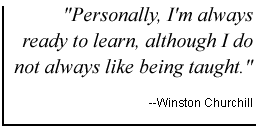
Learning, by contrast, is a much larger umbrella that covers all our efforts to absorb, understand, and respond to the world around us. Learning is social. Learning happens on the job every day. Learning is adapting, and it is vital for the survival and well-being of individuals as well as organizations.
Traditional training has structure and boundaries. Learning can break through boundaries to expand or reconfigure knowledge in new ways. The Canadian Centre for Management Development, in a report on continuous learning, puts it this way:
Training is something that is done to you, or that you do for someone
else. Learning is something you do to and for yourself. Training implies
that something already known is to be transferred to someone else.
Learning, by contrast, implies a process of self-directed exploration
and discovery, in search of something not yet known, something yet to be
found.16 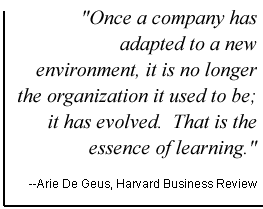 In the government, traditional training has
been the function of the human resource development (HRD) practitioner
in the personnel or training office. Managers have typically contributed
to the training process by identifying their employees' training needs,
initiating training requests, and sending employees to agency training
programs.
In the government, traditional training has
been the function of the human resource development (HRD) practitioner
in the personnel or training office. Managers have typically contributed
to the training process by identifying their employees' training needs,
initiating training requests, and sending employees to agency training
programs.
This situation is reversed for learning. That is, managers must take the lead in setting up the environment for learning, and HRD practitioners must contribute support. The remainder of this chapter lays out a roadmap for you to:
- eliminate the barriers to learning,
- set up individual and organizational learning strategies,
- get strategically aligned, and
- make a plan.
Before any meaningful learning can be initiated, five principal barriers must be overcome. As identified by R.L. Dilworth, these are:17
- treating learning as an individual phenomenon, rather than as
something that can also involve groups of people;
- focusing on formal training, rather than attending to informal
workplace learning;
- keeping business and learning processes as entirely discrete
worlds;
- tolerating "nonlistening" work environments; and
- employing autocratic leadership styles.
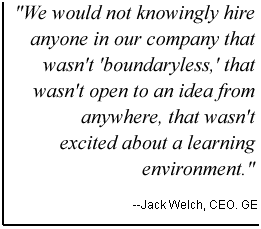 These barriers exist in many government organizations, and
unless they are removed, organizations cannot be designed to learn.
These barriers exist in many government organizations, and
unless they are removed, organizations cannot be designed to learn.
You have considerable power to make the necessary changes in your own organizational unit. For example, you can demonstrate new behaviors and set up new systems that encourage openness and communication. There is much to be gained by breaking down the barriers: the ability to learn is not measured by what the organization and manager know but rather by how the manager and organization learn.
Set Up Individual and Organizational Learning Strategies
There is a significant difference between individual and organizational learning. Consequently, different strategies are needed for each.
Individual learning is a familiar concept: it is the ability of individuals to experience personal growth in their exchange with the world around them. Organizational learning is perhaps less familiar. Certainly, it is a much more recent concept: it is the ability of an organization to gain insight and understanding from experience. Groups and organizations adapt, grow, and change as units to shape their future course.
The idea of organizational learning was popularized by Peter Senge in The Fifth Discipline: Mastering the Art and Practice of the Learning Organization.18 Its publication generated a significant level of interest worldwide. Since then, organizational learning has become highly valued by corporate leaders because of the systems-level learning that occurs when entire organizations address and solve problems, build repositories of lessons learned, and create core competencies that represent the collective learning of employees, past and present.
Individual and organizational learning are distinct, but not separate. Individual learning is the foundation of organizational learning, but it does not lead automatically to learning by the organization. As Argyris and Schon put it: "Individual learning is a necessary but insufficient condition for organizational learning."19 You can use techniques and tools to promote each of these and link them together.
Individual Learning Strategies
There are two types of individual learning: formal and informal.
Formal learning encompasses all traditional training in structured
courses, classrooms, and formal development programs. Informal
learning is that which takes place in the informal processes of
everyday work. 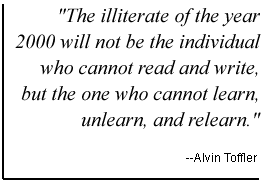 Most individual learning occurs informally, rather than through
formal training or education.
Most individual learning occurs informally, rather than through
formal training or education.
While managers can do much to influence and reinforce formal learning, you can have the greatest impact by deliberately creating a climate for informal learning. Here are some strategies for informal individual learning that, although they cost very little in time or money, have potentially big payoffs:
- Job rotations permanent or temporary appointments to new
positions. These appointments should be planned to stretch and challenge
employees, and to broaden their understanding across different business
processes of the organization.
- Special assignments tasks or projects given as learning and
development experiences. These can be specifically designed to offer
opportunities to explore new areas and learn new skills.
- Reflecting on experience a process of integrating learning
and work to give both conscious attention. Given a special assignment or
period of work, an employee is asked to analyze the results achieved,
lessons learned, and new opportunities for learning.
- Coaching and counseling learning assistance given to the
employee through listening, observing, and providing feedback. Managers,
team leaders, or senior colleagues are in an ideal position to provide
such assistance, and can exploit everyday workplace exchanges into
"teachable moments" for maximum learning benefit.
 Mentoring oversight of an employee's career
development by someone senior to the employee and outside the employee's
chain of supervision. Mentors help employees clarify career goals,
understand the organization, analyze strengths and developmental needs,
build support networks, and deal with road blocks.
Mentoring oversight of an employee's career
development by someone senior to the employee and outside the employee's
chain of supervision. Mentors help employees clarify career goals,
understand the organization, analyze strengths and developmental needs,
build support networks, and deal with road blocks.
- Manager as teacher managers acknowledge their role as
teachers and facilitators of the learning process, and regard each
interaction with employees as having a learning dimension. Managers
consciously teach through their own model, habits, and system of
values.
- Learning teams teams of four to five people who meet
regularly to focus on individual learning to improve their own
effectiveness. Teams can form around an area of interest, such as the
Internet or public speaking, or around broadly defined career
paths.
- Self-development a collection of techniques and approaches
for individuals to manage their own process of learning. These include
self- analysis of competencies and interests, personal development
plans, learning contracts, learning logs, reading lists, involvement in
professional organizations, networks, attending demonstrations at other
organizations, and participating on interagency committees.
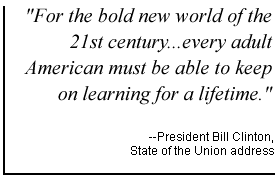
- Individual development plan (IDP) a plan developed jointly
by the employee and manager that identifies individual goals for
employee growth in the context of organizational mission. The plan lists
training, education, and development activities (formal and informal) to
develop the competencies needed to meet IDP goals.
Organizational Learning Strategies
Organizational learning is still in its infancy within the government, because a history of bureaucracy, compartmentalization, and segmentation has not provided much fertile ground for openness and communication. Yet managers can design organizations that learn and that are able to transform themselves to respond rapidly to technological change, downsizing, and restructuring. And when organizations are designed to learn, the lessons are not lost when individuals leave.
Here are some strategies for organizational learning: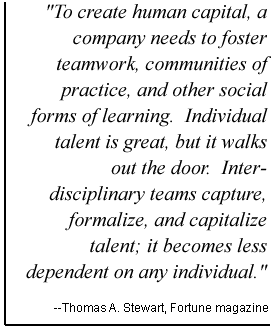
- Meetings time in regular meetings used for learning
purposes:
- Time is set aside for presentations from outside resource people
giving a different perspective on agenda items. In this way, real
business is used for learning and gaining new insights.
- Periodically, a facilitator is brought in to take the group
through team-building exercises to improve communication and
understanding.
- Employees who are working on special assignments or reading
professional literature are asked to make reports.
- In meetings, managers play the role of teacher by asking
questions, demonstrating systems thinking, and discussing lessons
learned.
- Action learning an actual problem in the workplace used for
learning. A group of employees is formed to analyze the problem and
consult with experts. The group then returns to the workplace to take
action. After a period of time, the group reconvenes to discuss progress
and make adjustments. This cycle of action and learning repeats itself
until the problem is satisfactorily resolved. Case studies are written
up as final reports and become part of organizational historyand
required reading for new employees.
- Cross-functional teams individuals with different skills
and backgrounds form a team to bring a wide range of viewpoints to
accomplish some task. They collaborate on common work issues and learn
from one another. Through this, they acquire greater knowledge of the
complexities of business issues and decisionmaking
processes.
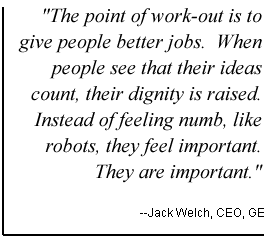
- Work-outs an organizational equivalent of a town meeting.
This technique has been practiced extensively at GE and is credited as a
factor in transforming that company into one of the world's most
successful corporations. Teams composed of a broad spectrum of employees
at all levels meet without management to seek answers to business
problems. The work-out concludes with a town hall style meeting where
teams present their proposals to management. The managers must make
immediate, public decisions as to whether to accept or reject the team
proposals, or ask for more information by a specific date. The work-out
process brings to bear all levels of the organization and encourages
open and frank discussion about practical problems.
- Strategic planning groups working together to predict and
prepare for their future. Through various planning processes, employees
gain insight into the real business goals and priorities of the
organization and the value of their contributions. Facilitators can lead
a group through processes to develop mission statements, a strategic
five-year vision, expected outcomes, and critical success indicators to
measure progress. Building scenarios and analyzing the "what if's" are
processes that help organizations prepare contingency plans for a wide
range of possibilities in the future. Through strategic planning,
organizations learn more about themselves, develop a common language,
and chart a direction that is understood and "owned" by
everyone.
- Parallel learning structures temporary study groups created
to open new channels of communication outside and parallel to the
normal, hierarchical structure of the organization. The study groups cut
across organizational lines horizontally and vertically, define their
own boundaries and strategies, and bring new thinking and creative
energy to problems that have challenged normal decisionmaking
processes.
- Corporate scorecard the business equivalent of a
speedometer or temperature gauge that tracks measurements that are
important to the success of the organization. The scorecard tracks both
financial and nonfinancial measures, including customer service,
delivery time, improved quality, and other factors that contribute to
organizational performance. The scorecard is distributed across the
entire organization so that everyone is reading the same score and can
address any given problem from a common ground.
- Benchmarking continually comparing your own organization
with other organizations. The procedure consists of:
1. identifying an area of your own organization that needs improving,
2. scanning the environment to find "model" organizations that have a recognized ability or accomplishment in that area,
3. studying the practices of this model organization, and
4. finding those features that can be adapted to work in your own organization.
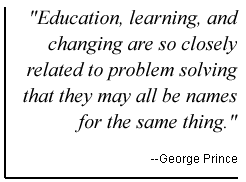 Benchmarking is an unending search for best practices that can
help an organization improve its own performance.
Benchmarking is an unending search for best practices that can
help an organization improve its own performance. - "Flocking" a technique derived from species of birds that
"flock," or assemble together in small groups to learn collectively.
These birds learn faster than other birds, and so do organizations that
encourage flocking behavior.20
Team training provides an excellent opportunity for flocking. On-site university programs allow employees to learn together, exchange information on real projects, and establish ongoing networks. Management development programs bring together leaders from various backgrounds and promote collaboration and communication across organizational boundaries.
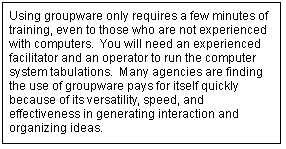 Groupware a computer-based technology that supports a
team's communication and decisionmaking processes. The system replaces
chalkboards and large poster pads with a projected computer screen image
and a series of networked workstations, each with its own private
display monitor. Participants can enter brainstorming ideas, make
comments, organize ideas and concepts, make evaluations, and vote for
rankings anonymously. Their input is instantly recorded on the
projection screen and on the other participants' monitors. The system
makes group work substantially more efficient, because less time is
spent tabulating comments, rankings, and evaluations; and it gives
instant access to a broad range of information about how work is
progressing. At the end of any exercise, the computer will print out a
series of products that capture the comments, statistics, and rankings
of the group.
Groupware a computer-based technology that supports a
team's communication and decisionmaking processes. The system replaces
chalkboards and large poster pads with a projected computer screen image
and a series of networked workstations, each with its own private
display monitor. Participants can enter brainstorming ideas, make
comments, organize ideas and concepts, make evaluations, and vote for
rankings anonymously. Their input is instantly recorded on the
projection screen and on the other participants' monitors. The system
makes group work substantially more efficient, because less time is
spent tabulating comments, rankings, and evaluations; and it gives
instant access to a broad range of information about how work is
progressing. At the end of any exercise, the computer will print out a
series of products that capture the comments, statistics, and rankings
of the group.
- Computer conferencing an application of computers and
telecommunications for distance learning that provides an "electronic
classroom" setting. Employees can interact with each other and with a
leader (a coach, facilitator, or instructor) on discussion topics,
problems, projects, and questions at their own convenience and at any
location.
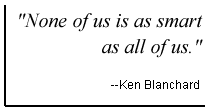 Computer conferencing software can be used to conduct an
actual class, complete with instructor, class assignments, and tests. It
can also be used for ongoing discussions and reviews of work by project
teams whose members are separated by time and space, or who simply have
difficulty finding time to meet.
Computer conferencing software can be used to conduct an
actual class, complete with instructor, class assignments, and tests. It
can also be used for ongoing discussions and reviews of work by project
teams whose members are separated by time and space, or who simply have
difficulty finding time to meet.
This list of strategies is only a starting point. As you begin to see every workplace exchange and activity as an opportunity for learning, you will generate your own ideas for organizational learning strategies. And, although you must take the lead in learning, managers should look to the HRD office for expert support in designing and implementing individual and organizational learning strategies. The HRD specialists should be able to provide more information about any of the recognized strategies described in this handbook and facilitate learning processes with employees
Strategic alignment refers to the correlation between an
organization's operations and its mission and goals. Ideally, operations
should support and reflect mission and goals. For our purposes, we are
here discussing the importance of aligning 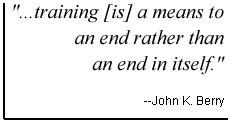 training and learning activities with the "big picture" that
is, with the organization's overall business strategy. In government,
there are several important reasons for ensuring that plans for building
human capital are linked to business strategy:
training and learning activities with the "big picture" that
is, with the organization's overall business strategy. In government,
there are several important reasons for ensuring that plans for building
human capital are linked to business strategy:
- First, serious concerns have been expressed in the past that the
billions of dollars spent on civilian training are not targeted wisely
and do not lead to improved performance.21
- Second, with downsizing and restrictions on hiring, new skills will
have to be acquired by training as opposed to recruiting.
- Finally, with dwindling resources, limited training dollars are not
likely to be increased in the near future.
In short, more must be accomplished with today's existing workforce and today's existing resources.
You can link learning to performance and organizational results by doing the following:
1. Review your agency's strategic plans and objectives. Every agency has a strategic plan, as mandated by the Government Performance and Results Act of 1993. This five-year plan describes how the agency will use its personnel, budget, and other resources to accomplish measurable performance goals.
2. Determine how you contribute to agency plans and performance requirements. What is your core expertise? What do you do best? Draw the relationship between your group's function and the mission, goals, and core competencies of the agency. Examine the ways you are expected to perform and the outcomes you produce. Are there potential new ways you could lead, support, or participate?
3. Plan learning that supports your ability to contribute to agency
objectives. Check the agency annual training plan to identify priority
training programs that involve your employees. Determine if your
organization has key positions in mission-critical areas that need
continuing professional education. Find out if your employees can explain
the organization's business strategies and specifics of their own group's
performance. Identify the competencies necessary to meet performance 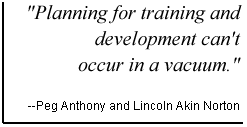 goals and the learning activities that build and strengthen
them.
goals and the learning activities that build and strengthen
them.
4. Focus on learning that addresses areas of performance weakness. Review the results of your organization's past performance. What are the strengths and weaknesses, and where are improvements needed? Most importantly, what learning can be done that will result in the biggest payoff to the agency in measurable results?
5. Create learning objectives that tie into business outcomes. Whenever possible, set up learning that directly relates to your organization's critical success indicators. For example, if the organization is measuring cycle time, or output, or customer satisfaction, try to build learning activities or select training courses with related objectives. This helps ensure that the changes in your employees' performance are the ones desired and the ones measured.
6. Support the transfer of learning into performance and results. On average, less than half of what is learned is actually applied on the job. There is no automatic transfer of new skills into new job behavior. You, as a manager, can influence such a transfer by fostering an environment that gives employees a chance to practice new skills, values innovation, and rewards improved performance.
As always, managers should look to the HRD office for expert support in aligning learning to business strategy. HRD specialists should be able to advise you on how to perform the steps above and to provide you with tools to make assessments and decisions about learning.
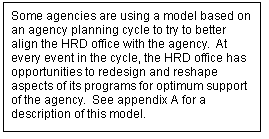 For its part, the HRD office should be taking steps of its own
to integrate training and development with all the other human resource
functions recruitment; retention; creation of new positions, work
systems, and performance management systems to align total performance
requirements with the agency's mission and goals. When all human resource
requirements and priorities have been integrated when it is known what
level of effort will be needed to move the agency forward for each career
area, for retraining efforts, for introducing new systems, for
reorganization and reinvention, for leadership managers gain valuable
information and insight on the kinds of learning that are strategic. This
in turn promotes consistency across all managers striving to link learning
to performance and results.
For its part, the HRD office should be taking steps of its own
to integrate training and development with all the other human resource
functions recruitment; retention; creation of new positions, work
systems, and performance management systems to align total performance
requirements with the agency's mission and goals. When all human resource
requirements and priorities have been integrated when it is known what
level of effort will be needed to move the agency forward for each career
area, for retraining efforts, for introducing new systems, for
reorganization and reinvention, for leadership managers gain valuable
information and insight on the kinds of learning that are strategic. This
in turn promotes consistency across all managers striving to link learning
to performance and results.
Recently, an office in a federal agency used its training funds to send several employees to expensive conferences and two executives to long-term executive development programs. Later in the year, when it came time to implement the agency's new automated procurement system, the office didn't have enough funds left in its budget to cover basic training. The office had to delay the use of the system until the next fiscal year, when it could afford to get its employees trained.
Situations like this occur across the government.
There's a straightforward way to avoid the "first-come-first-served" mentality that plagues many government organizations in allocating their training dollars: make a training plan. Such a plan is extremely useful for organizing thinking about investments in formal training. With limited dollars to go around, managers need an aggregate perspective to find balance, establish priorities, and separate merely good ideas from business imperatives.
When you plan for learning and training as an organizational unit, you gain powerful advantages and get results. With an annual training plan, you can:
- make a connection to the organization's strategic objectives
upfront,
- target training areas of greatest need and biggest payoff,
and
- find the best and most cost-effective ways to get
training.
Here are basic steps for you to develop a training plan for your organizational unit.
1. Define learning needs linked to strategic plans.
- Identify your contribution to your agency's mission, strategic
goals, and objectives (see the strategic alignment steps discussed
above).
- Check into the introduction of new technology and new ways of doing
business, both internally and externally.
2. Review other information to identify needs.
- Review reports, agency "scorecards," etc.
- Check the learning needs identified by employees, customers, and
other sources.
- Identify continuing professional education requirements for career
programs.
- Determine if your group is fully oriented to the agency's business
strategy.
3. Validate your list of needs.
- Ensure that all the needs are learning needs.
- Determine if training is an appropriate intervention.
- Figure out how it contributes to the overall solution.
- Rank the requirements in order of importance to the strategic
plan.
4. Determine the best strategies.
- Make "business case" decisions based on your resources (time, money,
and agency programs and assistance available to you) and potential
payoff.
- Consider formal learning options:
- classroom vs. on-the-job,
- on-site vs. off-site,
- customized vs. off-the-shelf (the latter can be acquired and used
as is);
- contractor vs. in-house instructor; and
- technology-based delivery (computer-based training, satellite
broadcasts) vs. classroom instructor delivery.
- classroom vs. on-the-job,
- Consider informal learning strategies for:
- individual learning, and
- organizational learning.
- individual learning, and
5. Identify potential sources for learning.
- Obtain information from the HRD office on:
- recognized vendors,
- partnerships with other organizations, and
- colleges and universities.
- recognized vendors,
- Check into possible collaborations with other
managers.
6. Estimate costs.
- Include tuition, travel, per diem, facilities, contracts, and
special equipment.
- Weigh projected costs for different strategies and
sources.
7. Set priorities.
- Select the critical areas that most need addressing.
- Identify the potential payoffs.
- Determine your funding level, and where must you draw the
line.
8. Determine how to evaluate results.
- Identify the measurable outcomes you expect to have.
- Make the link between outcomes and business strategy.
- Find a simple way to track progress.
9. Share your plan with employees, customers, and other managers in your organization.
- Generate understanding and promote "buy-in" of the plan.
- Lead by example; demonstrate your commitment to learning for
results.
10. Execute and monitor.
- Assign responsibility to implement the plan.
- Collect evaluation data, including data for baseline
measures.
- Track your group's contribution to the agency's strategic
goals.
- Document success stories.
- Make additions and adjustments to the plan as
necessary.
- Track your group's contribution to the agency's strategic
goals.
- Continuously provide opportunities for employees to apply their
learning on the job.
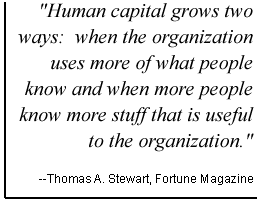 The HRD office can advise managers on developing annual training
plans. The HRD staff can provide valuable information on the best
resources for training, how to estimate the actual costs of training, and
how to evaluate the value of training.
The HRD office can advise managers on developing annual training
plans. The HRD staff can provide valuable information on the best
resources for training, how to estimate the actual costs of training, and
how to evaluate the value of training.
The best HRD offices make organizationwide master training plans
these can be a significant help and resource to managers in making their
own plans. HRD master plans link learning and organization strategic plans
at the highest level, and describe large-scale training initiatives that
contribute to agency goals and performance requirements.  You can then build on the platform of these master training
plans and fill in the blanks for your own unit.
You can then build on the platform of these master training
plans and fill in the blanks for your own unit.